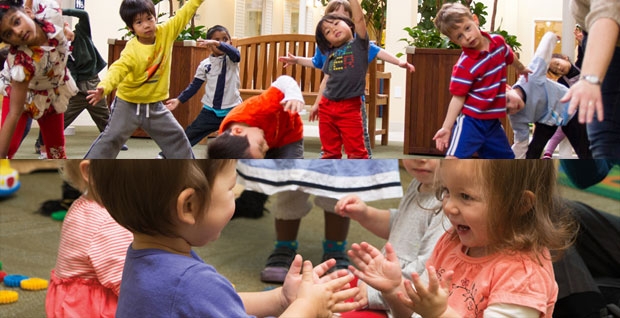Child care in Oregon is expensive and hard to find. We delved into the numbers and talked to a few executives and managers about day care costs, accessibility and work-life balance.
Oregon is one of the least affordable states for infant and pre-school day care. It ties in second place with Colorado as the most costly state in the nation relative to median income for infant care, and the third mostly costly state for center-based care for a four-year old, according to ChildCare Aware of America, an advocacy group. Oregon’s low median income and high living costs relative to other states means parents have to shell out a higher percentage of their salary to pay for day care than in other parts of the country. Day care prices “are especially challenging for parents in a relatively low-income state,” says Bobbie Weber, research associate at the College of Public Health and Human Services, Oregon State University.
The top 5 least affordable states for center-based infant care in 2013
Source: ChildCare Aware of America
Rank | State | Average annual cost of infant care in a center1 | Cost of care as a percentage of median income for a single mother | State median income for a married couple2 | Cost of care as a percentage of state median income for a married couple |
1 | New York** | $14,508.00 | 56% | $91,525.00 | 15.9% |
2 | Colorado | $13,143.00 | 47.8% | $85,961.00 | 15.3% |
2 | Oregon | $11,078.00 | 51.6% | $72,631.00 | 15.3% |
4 | Minnesota | $13,993.00 | 53.7% | $92,299.00 | 15.2% |
5 | Massachusetts | $16,549.00 | 60.6% | $111,368.00 | 14.9% |
Sources: 1NACCRRA’s January 2014 survey of Child Care Resource and Referral State Networks; 2U.S. Census Bureau, American Community Survey, 2010-2012 three-year estimates
**2011 data, adjusted for inflation.
VOICES: Amy Donohue, principal, Boora Architects
Donohue and her husband, architect Paul McKean, have two kids, ages four and eight. They put their eldest daughter’s name on the waiting list for a Montessori school when Donohue was five months pregnant — and snagged a spot nine months later. “So I was on the waiting list a year and they require a down payment, the whole works.”
When their second daughter was born, the couple decided to hire a nanny. “At that point you start to look at two kids in daycare and then it begins to make more financial sense to just hire someone to come to your house.”
“Child care costs are not affordable to a lot of people,” Donohue says. “If you have kids as you have gotten older and are in the upper level of salaries then you are better able to afford it. But it’s a real challenge for people who are younger. I have heard anecdotally for younger architects that the first one they can afford; the second one, someone has to decide to stay home.”
The top 5 least affordable states for center-based care for a four-year-old in 2013
Source: ChildCare Aware of America
Rank | State | Average annual cost of care for a 4-year-old child in a center1 | Cost of care as a percentage of median income for a single mother | State median income for a married couple2 | Cost of care as a percentage of state median income for a married couple |
1 | New York** | $12,280.00 | 47.4% | $91,525.00 | 13.4% |
2 | Vermont* | $10,068.00 | 42.0% | $80,663.00 | 12.5% |
3 | Oregon | $8,615.00 | 40.1% | $72,631.00 | 11.9% |
4 | Nevada** | $8,208.00 | 29.2% | $70,397.00 | 11.7% |
5 | Minnesota | $10,812.00 | 41.4% | $92,299.00 | 11.7% |
Sources: 1NACCRRA’s January 2014 survey of Child Care Resource and Referral State Networks; 2U.S. Census Bureau, American Community Survey, 2010-2012 three-year estimates
*2012 data, adjusted for inflation
**2011 data, adjusted for inflation
VOICES: Will Rasmussen, partner, Miller Nash
Rasmussen and his wife, also a lawyer, pay $1,400 a month to enroll their 1 ½ year old daughter in the Fruit And Flower child care center in NW Portland. They were on the waiting list for 14 months. “Fruit and Flower is very deep into the data of raising young people,” Rasmussen says. “I have more confidence in the staff to engage the right side of her brain than when she’s hanging out with me.”
“We’re financially very fortunate, but I don’t know how somebody on a standard median income makes it all work,” Rasmussen says. “It’s a huge chunk of money.”
Supply squeeze
The supply of child-care facilities in Oregon is not enough to keep up with demand as evidenced by long waiting lists. Anecdotally, waiting lists for day care centers in Portland average one year or more. The number of registered family facilities, which care for up 10 children (two of which can be under two years of age), declined 61 percent between 1999 and 2014. Oregon State University’s Weber says this decline in family facilities, which is happening nationally, is the result of parents preferring center-based care to home-based care. Reasons include parents’ perception that center-based care is safer because of multiple adults caring for children, and the belief that early learning is better supported in centers.
The number of larger facilities has grown more steadily between 1999 and 2014, but not by enough to keep up with need. Certified center facilities, which provide care for more than 12 children in a building other than a single-family residence, increased nine percent over the same period. The number of certified family facilities, which provide care for no more than 16 children in their own home, increased more than twofold.
Number of child-care facilities 1999-2014
1999 | 2002 | 2004 | 2006 | 2008 | 2010 | 2012 | 2014 | |
Certified center facilities | 973 | 976 | 956 | 973 | 1,020 | 1,020 | 1,041 | 1,062 |
Certified family facilities | 198 | 194 | 247 | 332 | 446 | 526 | 614 | 627 |
Registered family facilities | 6,251 | 4,250 | 3,675 | 3,007 | 3,089 | 2,999 | 2,511 | 2,424 |
VOICES: Kim Malek, owner, Salt and Straw
The ice cream entrepreneur has three children, ages 7, 5 and 2. The youngest attends Woodsong preschool near Malek’s house in SE Portland; the two older kids attend Atkinson Elementary. “I’m lucky that I own my own business,” says Malek, whose partner is a doctor (“with an inflexible schedule.”) Malek wakes up at 4:30 in the morning and works until 7 a.m. when the kids get out of bed. She works again at night after the children have gone to sleep.
“We have arranged our life so we can live next to the public school,” Malek says. “We’re pretty judicious in trying to find schools and activities that are hyperlocal. But we’re fortunate to have the flexibility.”
“To be honest, when I first started looking for child care, I was taken aback how expensive it was.”
VOICES: Fred Tibayan, heart surgeon, OHSU
Tibayan and his wife, OHSU cardiologist Yen Tibayan, pay $2,478 per month to send their two kids to the OHSU Healthy Starts Childcare center in South Waterfront. “It’s easy for us to pop in for an art show; it’s an easy pickup,” Tibayan says.
“Childcare is traditionally undervalued by society. It costs a lot for what a lot of families have in resources. We feel very lucky that this works for our family.”
VOICES: Anne Hoffman, advertising account manager, Coates Kokes.
Hoffman and her husband have two children: a 4-year-old and seven month-old. The four year-old attends Growing Seeds child care center in NE Portland. “It’s a total Portlandia sketch,” Hoffman says. “They have their own farm that supplies their own fruit, vegetables and meat. If a child is in diapers, they have reusable diapers.”
To get ahead of the waiting list game, Hoffman told Growing Seeds about her second pregnancy “before I told my parents.” No such luck. Growing Seeds accepts new enrollees once a year, in September. “I didn’t time my pregnancy right,” Hoffman says.
Getting kids into daycare “is worse than getting into college. The waiting lists are so stressful.”
“I honestly don’t know what the answer is to the (U.S.) child care problem,” says Hoffman, who spends $2,500 per month on child care. “We sort of did the math: how much we are really paying [child care workers] to take care of them per day? It’s not much that money and you’re handing over your greatest asset.
Maybe we could move to Europe? My husband and I are really fortunate to be able to afford to send them to a place where we feel comfortable and get good food and good care. I complain about it on the one hand. But if we were in a different situation, a single mom — I don’t know how they do it.”
Linda Baker contributed to this report.




